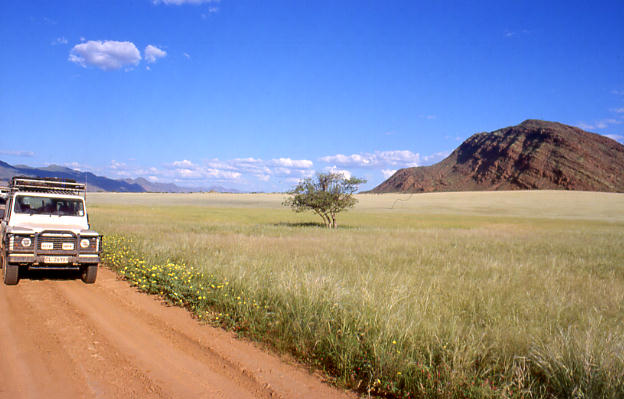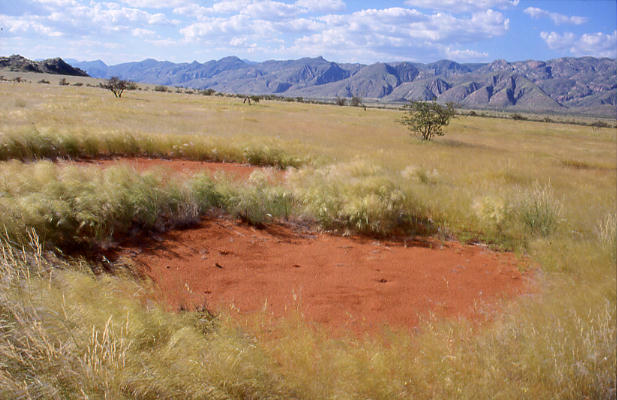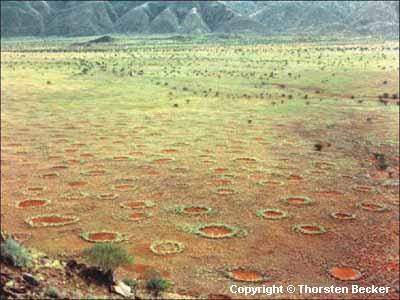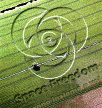
Among the phenomena belonging to
the soil and to the circle shape, in my opinion, one of
the most fascinating is the 'Fairy circles', particular
circumferential areas without plants typical of the
Namibia landscape, "unpopular" state of Africa but full
of nature, of enchanting and unchangeable landscape,
characterised of great silences and of breathtakingly
beautiful skies.

It is a such ancient phenomenon (the local tribes
“know” it all along) and a such particular one that any
African tourist tour crossing the region of Marienfluss,
in the Kaokoland of Namibia, would not stop for a
sightseeing of these particular circular formations.

Further
the spread of a survey results of this phenomenology,
lots of international newspapers1,
last week, wrote of African circles and, in the coming
days, when the traditional crop circles “season” will
start again at full steam, we would like “to match” the
two phenomena that, although so different, suggest
sociological considerations that have not to be
disregarded.
It would
not be correct to think to the Namibian phenomenon as
one of the “misteries” that just recently have
interested the science. By a careful evaluation of the
things we are aware that the science have been
interested in 'Fairy circles' for more than 30 years. We
have known of studies published since 1974 up to 2000.
The most representatives are the following:
The last
one is, in chronological order, the survey of the
researcher Gretel van Rooyen, a botanist of the
University of Pretoria. The professor van Rooyen,
exclusive for New Scientist3 ,
declared that the appropriate laboratory tests that she
performed suggest that the 'Fairy circles' phenomenon
could depend on something toxic allowing the plants to
grow inside the circles thus rejecting, as per the new
tests, some old ideas. Nothing more, as things stand
now, she is able to add, unless that these circles still
are an open research field, a challenge for the science
that, for example, will have to explain the whys and the
wherefores inside a possible toxicity in those places.

If
therefore it seems controversial and not possible to
define yet what the fairy circles are, we can try to
analyse what, of sure, as per the studies and researches
above mentioned, it is known of these circles.
In the
Kaokoland, the area of fairy circles gathering is
bordered by the regions characterised by deposits of
sands and annual rains ranging from 50 and 100
millimeters.
The
analysis of the air photos shows that the fairy circles
spread mainly in the West part of Kaokoland.
The total distribution
area corresponds to about 3500 km2

One
typical characteristic of fairy circles is the line that
marks the circles, made of tussocks,a long
and thick grass. In general, these tussocks
belong to the same kind of grass as the plants around
although their appearance is more flourishing.
The
average diameter of the circles is between 5 and 8
meters and, inside, it is without plants.
Tinley
(1974) considered the circles as the fossils of termites
activity, belonging to the period where the rains were
heavier than present time.
Another
explanation for the circles was the allelopatic
interaction4 between the euphorbia
damarana and the contemporary plants (Theron
1979).
According
to Moll opinion (1994), the termites are likely the
agents of fairy circles formation upon the specific
performance of the Hodotermes mossambicus. Becker
and Getzin (2000) share the termites hypothesis as well.

Besides
these, there are further explanations and different
believes about the circles of Namibia: variations of
electromagnetic waves, minerals in the soil, radiations,
meteoric origin causes, ufological phenomena, dancing
spirits and, finally, the official explanation (and
traditional) of Himba people (the ethnic group living in
the circles region) supporting that the circles have
been always there as creation of their gods.
Whatever
is the truth it is fascinating to note as different
people with different cultures (the endemic people and
the “people” of tourists) look at the sky to understand
the most complex mysteries of the nature; I would like,
about this, finish this “chat” on 'Fairy circles'
quoting what is written in a diary by an European woman
travelling to Namibia: “During the trip in the morning,
our guide Sylvie showed the characteristic place, really
particular. The blond grass on the dunes is shaped in
circles… it reminded me our crop circles. This is the
phenomenon named Fairy circles and there are lots
of explanations: some local tribes say that they
originated there by the oryx fights5,
the scientists visiting the circles, speak of
underground effects of the termites or of the poisoning
caused by a little flower similar to the Eidelweiss.
"And what about the extraterrestrial activity?" I ask
again…..
Last night
I raised my head up to the stars….
Margherita Campaniolo
Translation in English of Dr.
Giuseppina Cusenza
1-
http://cooltech.iafrica.com/science/313245.htm
http://www.news24.com/News24/Technology/News/0,,2-13-1443_1506184,00.html
http://news.bbc.co.uk/2/hi/africa/3587431.stm
http://theaustralian.news.com.au/common/story_page/0,5744,9150717%255E29677,00.html
2-
http://www.urbanfischer.de/journals/baecol/content/issue2_00/4010021a.pdf
3 -
http://www.newscientist.com/news/news.jsp?id=ns99994833
4
- Allelopaty= Some vegetables release allelopatic
substances that afflict the physic-metabolic processes
involved in the growth and in the development of the
near plants with particular regard to the processes
regulating the consumption of the nourishing elements
from the soil causing the death of the plants.
5 -
Oryx=
Sabre Antelope
- Antelope of Namibia
A particular and personal thank
to Massimo Giorgio for allowing me to use some of his
beautiful pictures of Namibia. Other photos, real
travel reportage, can be viewed on the link
http://www.worldisround.com/articles/22108/
and to
Dr.
Thorsten Becker for
pictures of "Fairy Circles".
Thank you very much.








